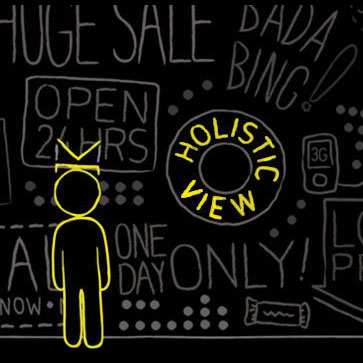Fishing for Leads (Feature)

"There's a fine line between fishing and just standing on the shore like an idiot." That's a line from comedian Steven Wright, and depending on how well your online/digital lead generation efforts are performing, you are either famed fisherman Babe Winkelman, or just some idiot with a pole wasting time.
Lead generation is one of the hottest topics in digital marketing today, and the funny thing is, it always has been. Ask any Web professional what their top priority is right now (or has ever been) and you'll likely hear that it is to drive more sales, more conversions, etc. Why would it be anything else?
Often, however, Internet professionals confuse the lead generation process with pure "acquisition" efforts alone. A company's efforts in this regard, however, won't be truly productive if all the brand does is acquire leads. It's also important to engage and, ultimately, convert prospects at a rate that exceeds expectations and cost, of course. Essentially, you can't just hook them, you have to reel them in, get them on the boat and then repeat the process.
Business demand for more and better customers (and acquiring them faster, of course) is accelerating each digital day. Internet professionals know that marketing tactics, such as search engine optimization (SEO), digital advertising, social media and email, can be used to generate and produce leads (or at least acquire more website visitors) for the eventual sale of new or existing products and services (be it immediately or over a longer period of time). And most Web workers have a handle on how to ensure those leads meet their company's high engagement expectations - particularly those that have read Website Magazine's June cover story (Engagement: The Digital Laws of Attraction).
Nevertheless, you (and likely your competition) still don't have enough leads to sustain your enterprise. What's the underlying problem? Despite having the necessary skills, experience, knowledge and resources (let's call it the gear, the bait and the secret fishing spot), brands are still struggling to generate the necessary leads cheaper, faster and in a more high-volume and quality-driven manner. Why? They're likely not thinking strategically about nurturing those prospects for the purpose of acquiring lifelong customers.
ACQUISITION SUPER GUIDE
If more visitors is what you're after, and who isn't, then check out Website Magazine's "Acquisition Super Guide." Readers will find hundreds of ideas to attract the big fish (along with a few smaller ones too). Take it to the next digital level today.
Digital brands simply need to pull it all together, from the marketing and design to the analysis and actual service element. Internet professionals need practical strategies and actionable techniques for each step of the lead generation process and access to best-of-breed software solutions along the way to accelerate their 'Net success. With any luck, this approach will bring in the big fish that will sustain an enterprise, be recalled fondly in personal memoirs and hung above the corporate fireplace for all to see. In a fast-moving industry like that of Web business, however, that's often easier said than actually done.
EVERDAY CRM
Learn more about how to handle the implementation and day-to-day operations of customer relationship management systems in Website Magazine's "CRM Blueprint 2013".
TEACH ME TO FISH
The Process Matters
Lead generation or "lead gen" is essentially the practice of marketing to generate consumer interest or, more accurately, an "inquiry" into a brand's products or services. There are myriad reasons why a business might engage in a lead generation campaign, but it ultimately comes down to one thing: making more sales. As Peter Drucker once said, "The purpose of a business is to create a customer."
To be successful at lead generation it is vital to master the many elements of Web success. For that reason, we're reverse engineering the lead generation process. In this article, we'll explore the important foundational elements of CRM solutions first, then, move on to optimizing consumers' lead generation experience (via design), and finally on to sections where most of the discussion around the lead gen practice already revolves - acquisition and nurturing.
Before you engage in and use the tactics, strategies and software referenced and discussed below, assess how your enterprise currently acquires and manages its leads. Are you still storing your customer or prospect data in a spreadsheet application? Are you sending out the same emails to all of your prospects? Are you failing to recruit brand advocates for your referral program or simply not producing any material at all for use in content marketing campaigns and their distribution within search, email and social? If so, stop these negative practices and do your brand a favor by exploring the opportunities and benefits that come first through leveraging a robust, intelligent customer relationship management (CRM) system.
GEAR UP: The Role of CRM in Lead Generation
When I was a kid, fishing in my grandparent's pond, I kept the fish I managed to catch in a bucket (don't worry, this actually does have something to do with digital marketing and Web technology).
Now I could have thrown those fish back immediately, or left them in the hot sun for the farm cats to snack on later, but the fishing bucket enabled me to show the haul to my cousins and siblings. It was storage (temporary, of course, because they were eventually returned to the pond) and not unlike the storage CRMs provide. There's another important similarity between my fishing bucket and today's state-of-the-art customer relationship management systems: I was able to more closely examine the catch, understand it (if only a little perhaps), and use the insights gained through that exploration and experience to catch even more. That's exactly what a CRM system can provide your enterprise (the insights, not the fish) when you look at the practice of lead generation differently.
The amount of actionable marketing insight available from within a CRM can be staggering. Today's CRMs enable Internet professionals to deeply understand the preferences and behavior of an audience (a group of prospects or existing customers), as well as their recent buying activity and even their level of social influence (e.g. Twitter followers). When data of this type and nature is accessible, brands are in a better position to convert more of the leads they acquire and turn random website browsers into loyal, repeating buyers and in far less time, because they know more about them.
Ultimately, what CRMs can provide digital enterprises is a measurable opportunity to influence those "fish" that are swimming close to its bait whether they are current or prospective customers. That may be one of the reasons that CRM powerhouse Salesforce is acquiring a digital marketing platform like ExactTarget whose expertise in email makes Salesforce now by far one of the true leaders in the software industry. ExactTarget actually has a full suite of digital marketing solutions - from email and social to analytics and mobile - providing Salesforce users with better digital fishing poles so to speak to fill not just their buckets, but their plates when dinnertime (a need to close leads) actually comes.
CRM systems are vital components to lead generation campaigns, but they don't (or shouldn't) work alone. To be truly effective, enterprises must also have a variety of other software solutions integrated with their digital presence to support their sales initiatives.
For example, enterprises will need a content management system (CMS) to support users as they visit their Web properties and navigate through the available sales channels. Say that a user arrives and consumes a specific type of content, then another piece of content in the same category and then another. If you're tracking the consumption behavior of that user in a CRM, you will have near absolute confidence that they are very interested in a particular topic. When a sales person has access to that level of interest-based data, converting that visitor to a buyer is far easier than without.
Consider CRM and CMS solutions as terrific fishing buddies, which, when armed with additional software integrations - be that survey and or chat software - make the conversion "pickings" easy. Of course, the more the merrier on our virtual fishing trip. Take for example Insightly, a small business CRM solution featured in Website Magazine's recent Top 50 list on lead management solutions (see sidebar), which recently announced that its cloud-based application has been integrated with Microsoft Office 365 and Outlook 2013. What this means for digital-minded enterprise is that Insightly users (the small businesses) can manage customer interactions, leads, proposals and more directly from within Office applications as well as Outlook. How easy is that?
Running a lead generation campaign without a CRM (or deploying a CRM without the much-needed integrations) is like fishing without bait and without a bucket. Customer relationship management systems make your enterprise better prepared to handle today's more discriminating user, but our quest for the ultimate user does not end there.
FIND YOUR SPOT: In Pursuit of Quality Leads
The final touchpoint in a user's path toward actually becoming a lead is typically through a form, and it is to the form where digital marketers, designers and Internet professionals must turn their attention if they want more and better leads faster.
Put Form Design in Focus
It might seem strange to start at the end point of the actual lead conversion process, but there's a method to the madness. Forms of the past have been cumbersome to say the least, but as our collective understanding of the optimal digital customer experience matures, they (the forms) are becoming more effective. And when we design the "right experience," Internet professionals can eventually turn their attention to the more traditional discussion topic related to lead generation - acquisition - with confidence that leakage of quality leads won't occur (or if it does, certainly with less frequency).
50 TOP Lead Gen SOLUTIONS
See powerful software solutions for prospect, customer and lead management.
Designers have learned over time what is most appealing to sales prospects and the savviest Internet professionals are making quick work of standardizing these vital elements of the conversion process in each digital product they create. Pure, for example, is a set of small, responsive CSS modules (wsm.co/purecssmodules) that recently caught our attention. Pure can be used as the foundation of a website's (both the layout and styling) native HTML elements and common UI components including grids, buttons, menus and forms. This makes landing page development for the purpose of lead generation a far faster, and more importantly, standardized process.
Creating Optimized Forms for Lead Gen
Discover the steps toward developing optimized lead generation forms.
More on the Optimal Form
Many digital marketers fervently espouse the benefit of the short form over the long form and while it certainly has its place, some of these suggestions are misguided at best and downright dangerous in some instances.
Digital businesses need quality leads and folks, a name and email address just doesn't cut it in every instance. Short forms tend not to reveal intent, nor do they indicate the quality of said lead (regardless of whether the brand is able to connect an email address to a previous behavior or some social media profile). On the other hand, long forms can dissuade a prospect from ever entering information at all. Isn't there a better way?
The only way to ensure that forms support your enterprise in its quest to obtain more high-quality leads is to adopt a process from that point of contact that helps filter and refine the information available about a user. This ensures when the information is passed to the sales or marketing department, better decisions can be made and time spent can be more productive. For example, the use of qualifying questions makes a big difference in lead generation campaigns in that it is possible to understand the user better. For example, when is the user going to be ready to buy or when was the last time they purchased a related product? Or, what is their biggest challenge in purchasing a solution and what benefits do they see or expect to see from using what it is that you're selling or offering?
The answers might seem obvious to you, but it doesn't take a digital business maven to understand that having this information at the ready proves quite useful in the actual conversion process as brand sales personnel know more about the expectations of users, whether certain leads can be disqualified outright, and increasing in importance, that data can also be used to immediately start remarketing to them. That might seem aggressive, but a quick review of the growth of that now common place tactic proves that even if you aren't, your competitors likely are engaged in the practice.
SCORE 'EM, THEN PASS 'EM
Enterprises should strive to know as much as they can about their prospects before sending them to their sales team for the close, but which leads are more likely to buy? Enter lead scoring, a common practice in lead generation that prioritizes leads based on their likelihood of purchasing. Review Website Magazine's "Quick Guide to Basic Lead Scoring with BANT (Budget, Authority, Need, Timing)" and discover numerous services to help your enterprise score its leads for optimal selling.
Get 'Em Hooked: Social Acquisition in Focus
So far, your lead generation campaign (built with a powerful CRM system on the backend) is optimized to support sales initiatives and the marketing and design team is creating a digital experience conducive to generating the highest quality leads once users arrive on your website. So, what's next? Keep moving down the funnel, of course. It's time to talk lead acquisition.
Search, advertising and email have been lead generation mainstays for many years, but there's a new pond that Internet professionals are eyeing.
The channel where today's marketers have the greatest hope in generating leads and ultimately driving purchases is through social media. The verdict still seems to be out, however, on whether the investment that's been made already, and is still made, is really paying off. One thing is for sure though; it's not for lack of trying. Social networks are responding by optimizing their offerings (Facebook for example just reduced the number of available ad units in an effort to make its programs more accessible) and releasing programs with advertisers of all sizes in mind.
Twitter, for example, recently added the Lead Generation Card to its suite of Twitter Cards, which is a collection of programs that enable marketers to bring a richer user experience within an expanded tweet. Users interested in a particular offer can expand a tweet to see a description of the offer and a brand's call-to-action. Their name, @username, and email address is pre-filled within the card and upon submission by the user the data is shared with the brand advertiser. The best aspect of the program, according to Twitter, is that not only can brands drive deeper connections, but do so at a lower cost-per-lead compared to other marketing approaches. The program is currently only available to managed clients of Twitter but the network expects a global release soon. The lead generation process doesn't exactly end at the moment when users click submit, however. In reality, that's when the real work begins.
REEL IT IN SLOW:
Lead Nurturing with Content
If you want to keep the fish –- the leads - you catch or acquire, it's important to develop them, so their interest grows to a point where they will eventually purchase the product or services provided (without breaking the line). Better yet, keep them coming back to purchase more in the future.
Thanks to the variety of marketing automation solutions and their integrations with CRM solutions (see Website Magazine's "5 Marketing Automation Solutions to Remember" at wsm.co/acqret13), Internet professionals are now more efficient and better prepared to handle the broader lead lifecycle than ever before. While these solutions are undeniably powerful additions to the marketing tackle box, much work still needs to be done to actually land (convert) those fish.
Once a prospect is on the hook, in the virtual pipeline headed toward conversion, digital marketers must reel in their catch slowly through a process of consistent and relevant relationship and trust building.
In the sophisticated CRM landscape of today, nurturing happens/ occurs in a variety of digital forms, from email (e.g. the use of auto-responders) to search and advertising (e.g. retargeting), and let's not forget, social. To navigate these often-murky waters, leveraging the value of "content" can set your enterprise on a course not just for more leads but better leads too.
Content That Your Leads Need
The secret to turning a lead into a white-hot prospect is to provide value and not just run-of-the mill value, but genuine value, what users (your prospects) really, really want and when they really need it.
Let's return to the fishing example for a moment. When I was a kid, we didn't fish with expensive lures (no shiny jigs or wiggling spinners). Instead, we used the ultimate bait - bologna and corn. That sounds gross, and looking back it was, but something about that combination worked. Whatever the appeal, it worked better than the most expensive lures. The reason, I believe, was that it was more in line with the expectation and desires of the fish in that pond. The point of that little story is marketers have to give their users something they actually want and really need. And when you do that, you can further customize the acquisition strategy to obtain the right user and close the deal at the perfect time.
Ultimately, every content item produced should be unique and compelling, educating the prospect about different aspects of the problem or solution that your enterprise provides a solution for. But this pond runs deep and your content needs to match.
For example, many leads may only be interested in solving an immediate problem they are experiencing. In this case, they are only in the "awareness" phase so blog posts, articles and white papers will prove ideal. Consider those prospects just nibbling at the bait on the hook.
Once they bite however, the job of a digital marketer is far from complete. Those prospects will hold on tight, dig in as it were and seek out even more information, perhaps in the form of webinars or e-books (maybe even a live chat or two for an initial question). The process continues as they get closer to converting. Content may take the form of actual product demos or a software trial. The point here is that the closer a prospect gets to becoming a converted customer, their preferences for content changes, and your responsibility to nurture them should change as well.
Mastering Lead Generation
"It Was This Big"
Lead generation campaigns require support from every corner of the enterprise. They demand funding from the C-Suite, the most artistic and sophisticated efforts of designers, the savviest turns of phrase from copywriters, aggressive promotion by digital marketers, and constant attention from both sales and support personnel. Digital brands needing more customers may already be engaged in lead generation, but if you aren't getting enough good fish in the bucket, it's time to start over, think smarter and change how you approach fishing for leads.
LEAD GEN FACEOFF: Search vs. Advertising vs. Email
See the opportunities and challenges of each of these established channels and set your brand on a course for success.







